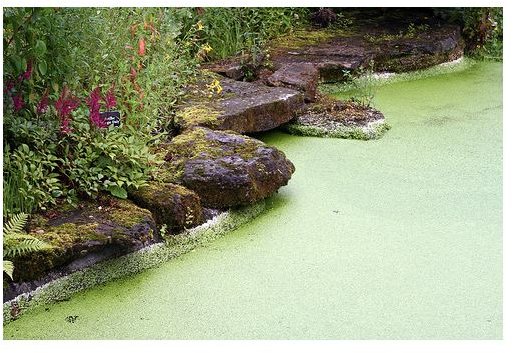How to Get Rid of Duckweed
Prevention is the key to controlling duckweed. Learning how to get rid of duckweed naturally starts with understanding why the duckweed bloom happened in the first place. Duckweed thrives when there is exposure to sunlight coupled with an excess of nutrients in the pond. Sunlight can be controlled only to a certain degree and dependent on the size of your pond meaning the majority of duckweed control will be achieved by limiting the nutrients available to duckweed.
Nutrient Control
Controlling the amount of nutrients in a pond starts with removing any sources of runoff that can enter the watershed. While lawn fertilizer is the major concern here, compost heaps placed in the watershed area can leech nutrients into the pond as well as any leaves left on the ground through the winter (especially leaves that decompose in the pond itself). Leaves and other organics can sink to the bottom of the pond where, if there is a lack of oxygen, anaerobic bacteria break down the organics into nitrogen components that are used as food by the duckweed plant. Installing a bottom aerator can help to reduce this problem as oxygenating the water will prevent a build-up an anaerobic bacteria. Don’t confuse this with the addition of a pond fountain. Although pond fountains do create movement and oxygenation at the surface of the pond, they do not provide an oxygen rich environment to the bottom of the pond where the anaerobic process occurs. A bottom aerator, in contrast, creates an oxygen rich environment at the bottom of the pond and prevents anaerobic activity, in turn, reducing the amount of nitrogen produced.
Skimming the pond manually with a pool skimmer twice a week can help keep the pond from building up organic decay, although it is impractical for larger ponds and does require a large amount of effort (this is where having a surface fountain may be an advantage as the water movement will push the duckweed closer to the edges of the pond making it easier to skim). This can reduce the number of leaves on the pond surface as well as help collect duckweed at the surface.
Evergreen Planting
In smaller ponds, it may be possible to reduce the amount of sunlight reaching the surface of the pond. Less sunlight means less potential for photosynthesis and less reproduction from the individual duckweed plants. Evergreen trees should be planted on the south and east side of the pond to prevent exposure to early morning sun. Deciduous trees should not be used because their leaves will pollute the pond and decay at the bottom over winter. This will lead to black matter accumulating and causing an early spring duckweed bloom.
Planting evergreens is not a solution to the duckweed problem but does serve a dual purpose. It is an additional step in reducing access to nutrients as the trees, if planted close together, act like a wind block and catch organic matter preventing it from reaching the pond surface in addition to blocking out early morning sun.
Add Fish
The most common natural duckweed control is the addition of fish to the pond. William E. Lynch Jr. an extension associate in aquatic ecosystem management at Ohio State University suggests the use of grass carp or Koi to control duckweed. Both of these fish are aquatic grazers, and although they will eat other pond plants as well, they will aggressively feed on duckweed.
Grass carp will grow to a size of almost four feet long and 40 pounds. The larger the carp get, the less likely they are to feed on duckweed and will turn to it as a last resort. Koi, on the other hand, rarely exceed two feet and will graze on duckweed continually, independent of what other food sources are available. Koi are also one of the most inexpensive solutions. Many Koi distributors will sell specimens that don’t meet certain ornamental standards at cost.
Another choice fish for natural duckweed control is tilapia. Tilapia are usually used as a stock fish for ponds. They will quickly reproduce and will need to be culled from time to time. The addition of tilapia may result in a secondary blue-green algae bloom due to the water composition change. There will be a large increase in nitrites and nitrates in a pond with the addition of the quick reproducing fish. The nitrogen cycle will eventually level itself out and the algae bloom will naturally recede. This secondary bloom may last up to a month but is only a one-time event.
Duckweed is best controlled by employing all of the above methods in conjunction with one another. Skimming and adding fish will give immediate results while limiting the amount of nutrients through plantings and reducing fertilizers in the watershed area will provide a long-term control. Again, learning how to get rid of duckweed involves learning why the duckweed is there in the first place. Identify your potential sources of excess nutrients and eliminate them, then add controls including underwater aerators and fish to prevent overgrowth of duckweed. There is no way to totally eliminate duckweed by using the measures mentioned above it can be controlled so you don’t end up with a green pond.
References
-
“SCDNR - Water - Common Aquatic Plant Management Problems.” South Carolina Department of Natural Resources. Web. 11 Aug. 2011. http://www.dnr.sc.gov/water/aquaff/duckweed.html
-
Image courtesy of Crinklecrankle.com @ FlickR, http://www.flickr.com/photos/garden_and_landscape_design_products/3428341869/sizes/m/in/photostream/
-
“Duckweed and Watermeal: Prevention and Control, A-14-04.” Ohioline. Web. 11 Aug. 2011. http://ohioline.osu.edu/a-fact/0014.html
